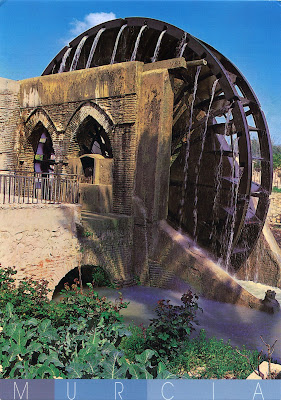 |
| 0024 The water wheel of Alcantarilla |
Between the 9th and 12th centuries the Arabs (or Moors, as the european have named the population who have conquered the Iberian Peninsula) had undoubtedly a civilizing role, leaving to Europe a legacy hard to ignore. Beyond the architectural wonders, from which Spain is full, they recovered and passed on the teachings of ancient Greece, to which have added their own not negligible contributions, be it mathematics, philosophy, alchemy, astronomy or medicine.
That time, the largest and most prosperous cities of Europe were those of Muslim Spain (Al-Andalus) and the court life compete with that of Constantinopole. While London or Paris were just pathetic clusters of hovels where no more than 20,000 dirty and lice peasants crowded, with ditches where people emptied their night pots on the middle of the streets, and pigs and chickens swarmed free among the passers-by, Cordoba have 113,000 houses, 600 mosques, 50 hospitals and asylums, 80 schools and 900 public baths (hammam), and major streets were lighted at night.
Alcantarilla (the Small Bridge), a town located at only 7km away from the capital of the region, the city of Murcia, was an independent town with a Muslim population until the 16th century and maintained its independence up until the present day, even if it’s completely surrounded by pedanías (satellite districts or boroughs) of the municipality of Murcia. One of its main tourist attractions is Rueda o Noria (water wheel), belonging to an irrigation system, assumed and improved by the Moors from the Romans.
The water-wheel or noria (from the Arabic naura) of Alcantarilla is just one of many that have operate between the 13th and 15th centuries around or on the Segura River. The first modern wheel was built in 1457 of wood, but in the nineteenth century was replaced by one of iron. The present wheel is from 1956, based on the proportions of the previous one from 1890 (11 m high, 1.90 m wide) and it’s part of the Museo Etnológico de la Huerta de Murcia.
About the stamp
The stamp, which depicted the buterfly Charaxes jasius (photography by Juan Daza), is part of Fauna set, issued on January 12, 2011. The other three stamps in the series (all with the same value - 0.65 EUR) are:
• Charaxes jasius - It's on the postcard 0024
• Melanargia ines
• Papilio machaon
• Argynnis adippe
Sender: Eric Clemente Figueira (direct swap)
Sent from Murcia (Murcia / Spain), on 24.10.2011
Photo: Angel Martinez

No comments:
Post a Comment